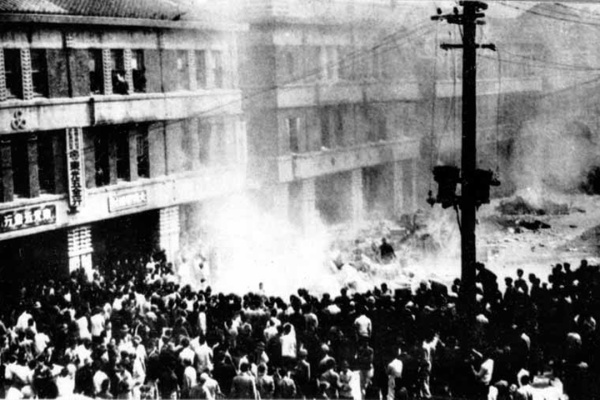228, also known as the February 28 Massacre, occurred in 1947 when the Chinese Nationalist Party (KMT) government of the Republic of China (ROC) violently suppressed an anti-government uprising in Taiwan.

What caused the tension that led up to 228?
Between 1895 and 1945, the Japanese ruled over Taiwan. During these years, the Japanese developed much of Taiwan’s infrastructure and economy, raising the standard of living for most Taiwanese people. These improvements under Japanese colonial rule contributed to the relatively favorable Taiwanese perception of the Japanese.
Following the victory of the Allied forces in World War II, Japan surrendered Taiwan to General Chiang Kai-Shek (leader of the ROC). In 1945, General Order No.1 placed Taiwan under the governance of the ROC, ruled by the KMT.
Chen Yi, the Chief Executive and Governor-General, took over Japan’s system of state monopolies on crops and commodities. He exploited this control to purchase goods at cheap prices and ship them to Mainland China, where they met Civil War shortages and sold at extremely high profits.
While the Japanese government had granted the Taiwanese opportunities to govern themselves, the ROC filled government positions with officials from Mainland China.
Further fueling the discontent of the Taiwanese people, undisciplined ROC troops looted, stole, and broke down the infrastructure built by the Japanese.
What happened?
On the night of February 27, 1947, agents from the Tobacco Monopoly Bureau attempted to confiscate contraband cigarettes from a 40-year-old woman selling them in front of a tea house in Taipei.
When she asked for the agents to return her money and cigarettes, one of the agents beat her on the head with his pistol. An angry crowd gathered to confront the agents for their excessive use of force. As the Tobacco Monopoly Bureau agents fled, one fired into the crowd, killing a bystander.
Compounding on existing discontent over rising unemployment rates, inflation, and government corruption, this incident sparked mass protests the following morning on February 28, 1947.
Initially, protestors marched on the Tobacco Monopoly Bureau to call for action against the agents involved in the previous day’s shootings. When a crowd swarmed the Governor-General’s office, his guards opened fire on the protestors.
This violence sparked an open rebellion that lasted for several weeks and resulted in tens of thousands of deaths.
The declaration of martial law on this day marked the beginning of the White Terror.
Rebellion:
Local leaders formed the 228 Incident Settlement Committee and presented the ROC government with the 32 Demands, a list of proposals for provincial administration reform. The list included demands for greater autonomy, free elections, and an end to government corruption.
However, a violent crackdown on the uprising began on March 8, 1947 when reinforcements from the Nationalist army arrived in Taiwan. By the end of March, Chen Yi had ordered the imprisonment or execution of all Taiwanese organizers that he could identify, killing between 3,000 and 4,000 people throughout the island.

Why isn’t this a well-known historical event?
Even after lifting the martial law in 1987, the government classified records related to the 228 Massacre as “top secret.” Speaking about the event was considered taboo.
The 228 Massacre remained unacknowledged for 48 years until 1995, when President Lee Teng-Hui, a victim of 228, issued a formal apology on behalf of the government. He declared February 28th as a national holiday, officially known as Peace Memorial Day, meant to honor and remember the victims of the 228 Massacre.
Since then, President Tsai Ing-Wen has declassified documents around the incident and promised further investigations by the government into the incidents surrounding 228.
Why does this matter to others?
There’s bigger context when it comes down to why this matters, and that is the history. To learn about your own history is to learn about yourself, while learning about other people’s history is to understand others better to fight back against injustice in the world
More from OFTaiwan:
Understanding 228 : More Than Just A Day in Taiwan
Walking through 228 : 10 Facts About 228
Other materials:
Taiwan president vows to uncover the truth behind 1947 massacre


Perhaps such a tragic history doesn’t need such a cheery retelling?
LikeLike
This is not a known occurence, and I appreciate learning about it. Many of us are very concerned about the future of an independent Taiwan, especially in relation to the current Russian overtake of an independent Ukraine. by another despot. Prayers for the people of Taiwan.
LikeLike
Kill Yourself, Robert.
LikeLike
Robert, I hate you. Perhaps you should get a real education?
LikeLike